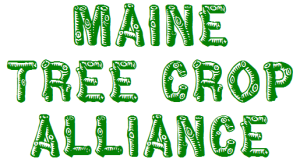—by Jack Kertesz, March 2018
If you came to the SCIONWOOD EXCHANGE intrigued by old varieties . . .
. . . take a moment and think about this.
In this room is evidence of a Pomological past, maintained for the present and likely preserved for the future. Some of the scionwood on the tables represent named varieties, brought over here from abroad. Others did not start out that way, but rather, a particular trait, either subtle or more likely rather striking, influenced someone to promote or popularize them. These might perform well and gain favor in one area, as small as a community, or as large as a region, like the foothills, the coast or some of the islands. They have attributes making them suitable for culinary endeavors, cider blends or fresh eating. They may be reliable croppers, store well or suit another need. All of them caught the attention of someone, and their popularity expanded as word got out. Propagating wood, like you see here today, was distributed or used to produce grafted trees to be sold or traded. More than a few of the varieties originated without the dedicated work of actual “fruit explorers” or trained pomologists. A passion, and even more so, frugal outlook existed, for “spreading the wealth”. Few of these treasures would be here today, without a rekindling of that spirit; a generosity and desire to know, respect and share in their pleasantries and diversity. Please do your part and pass along what you can.
Last Fall was a fairly decent year for apple production. Observed along roadsides, backyards and in the woods were grafted and “wild”, deer planted seedlings, running the gamut from sour to sweet, cosmetically beautiful, to rather not. This year, you might consider slowing to a halt and giving these a closer examination and a taste. Talk with your neighbors or the folks where these beckoning orbs hang. Find out what you can about their origin if possible, take a few notes on their qualities and mark down their location. Think about bringing fruit that you find to this Fall’s GREAT MAINE APPLE DAY– OCTOBER 14th, for possible identification, or just to share. You may become “hooked” as a Fruit Explorer, and join the ranks of those contributing to a more diverse and abundant future.
For some excellent photos on many of the varieties whose scions were here today visit www.applename.com I like this site in that it has pictures of cosmetically imperfect fruit, more relevant to what you might happen upon. You should also check out their identification guide if you want to be more clear about descriptors of each part of the fruit. Even the stem is a significant clue for identification! www.orangepippin.com Will take you to the “mother” site of the above. It includes a whole lot more varieties, many of which are only seen in Europe.
For some short but convincing reviews of a few varieties with nice photos.
https://fruitgardener.wordpress.com/category/reviews/ See also: http://adamapples.blogspot.com/
If you’d like to raise some high quality fruit and are less inclined to spray for pest and diseases, you may choose this person’s approach and bag your individual fruit. It sounds a little nutty to adopt this system, but it is an option that appears to work. http://gordosoft.com/orchard/bagging.htm
One pest not covered by bagging is found in the following publications online: Borers in New Hampshire Apple Trees or Round Headed Apple Tree Borer.
Further insight can be gleaned from a YouTube video: Discovering the Apple Borer with Michael Phillips. You will want to discover these critters or face losing your trees! A Borer Digging Video, as well as additional info on orcharding can also be found here. https://waldenheightsnursery.com/
Take the opportunity to learn about this one, small, insidious, BORING but significant pest that may be actively destroying your trees.
FIREBLIGHT, a disease which has been showing up in Maine, is highlighted in this Minnesota publication Integrated Pest Management for Home Apple Grower
Need more help with Grafting?…. A Spring Grafting Primer from MOFGA.
Now that you have your scions…..check out this PDF article Scionwood storage (a procrastinator’s delight; cut now, use later) by Greg Giuliani
The above information was prepared by Jack Kertesz, who continues to support people in their efforts to successfully grow fruit and nut trees, and a few other endearing species. You can read some vintage, yet informative newsletters, find useful advice on Fruit Exploring (and read this handout online) at the
Maine Tree Crop Alliance website http://mainetreecropalliance.org
The MAINE TREE CROP ALLIANCE also has a FACEBOOK page. Visit https://www.facebook.com/groups/mainetreecrops/ and ask to join
Got that Fruit Explorer Itch? Want to help spread it to others?
If this material inspires you in any way…I am looking for an assistant to move this type of information along. Please contact jkertesz@gmail.com .

